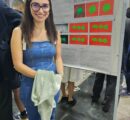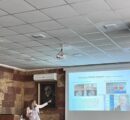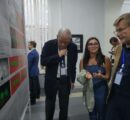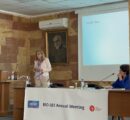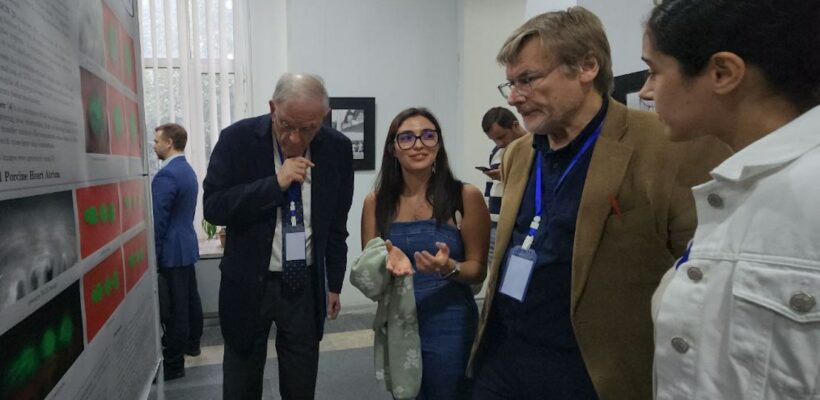
BIO-SEE 2023 Generates New Opportunities for AUA Faculty and Students
4 min readYEREVAN, Armenia — On October 16-18, the Annual Meeting of the Biomedical Imaging Organization for South East Europe (BIO-SEE) was held at the Orbeli Institute of Physiology. The meeting offered participants the invaluable opportunity to hear outstanding talks by local and international biomedical researchers. The event also included poster presentations by young researchers starting to step into the biomedical world. Several representatives from the American University of Armenia (AUA) Zaven P. & Sonia Akian College of Science and Engineering (CSE) participated in the meeting, including William Frazer Endowed Professor Dr. Narine Sarvazyan, CSE Assistant Professors Drs. Rafayel Petrosyan and Varduhi Yeghiazaryan, CSE lecturer Aram Butavyan, and General Education lecturer Dr. Rubina Danilova. Eight CSE students, including Arpi Hunanyan (MSCIS ’24), Nazeli Ter-Petrosyan (BSCS ’25), Arbi Balaban (BSCS ’25), Kamo Aghbalyan (BSCS ’24), Tigran Fahradyan (BSCS ’25 ), Davit Gyulnazaryan (BSCS ’25 ), Kristina Ghahramanyan (BSDS ’24), Aram Adamyan (BSDS ’24) and Hayk Hovhannisyan (BSDS ’24) participated in poster session activities as part of their AUA Biomedical Imaging and Cell Staining (DS 244) course.
As in the previous year, the meeting provided the ideal setting for exchanging expertise, while cultivating new ties between Armenian and foreign researchers. The event served as the right platform for young researchers to present their work before a professional audience and provided the attendees the opportunity to connect with the global biomedical imaging community. On the first day, Chair of the BIO-SEE Meeting Organizing Committee Dr. Narine Sarvazyan took the stage highlighting the role of the Annual Meeting: “BIO-SEE was created thanks to the Chan Zuckerberg Initiative (CZI) award, which aims to promote advanced bioimaging approaches across post-Soviet states. Armenia serves as the main hub of BIO-SEE activities, which provides a unique opportunity for attracting the world’s best experts in the field while giving more visibility to the activities of local researchers.”
During the meeting, Dr. Sarvazyan also reviewed the prior year activities of the BIO-SEE organization and outlined plans for future collaborative studies by her teams at the Orbeli Institute of Physiology and AUA.
This marked the second consecutive year in which Dr. Rafayel Petrosyan presented his research as part of the BIO-SEE initiative. Emphasizing the invaluable merits of this meeting, he remarked, “Such initiatives are very important for Armenia since they bring together researchers with different expertise from various countries and facilitate collaborative research.”
The study Dr. Petrosyan presented this year was titled “DNA Base Stacking Energies: Still a Mystery after 70 years.” Though over 70 years have passed since the discovery of the DNA double helical structure, the world still remains uncertain about the base stacking energies, as also observed in the study Dr. Petrosyan and his lab researcher, Lev Sukovatyi, have conducted. Based on two recently published single-molecule experimental studies, researchers have reported a number of significant disagreements between the different combinations of two DNA bases.
At the meeting, Dr. Rubina Danilova gave a talk titled “Advances in fMRI Research: Unlocking Secrets of the Brain.” She covered the incredible advancements in functional magnetic resonance imaging (fMRI) as a tool for uncovering the secrets of our brain. This technology bridges the gap between science fiction and reality, where the human capacity to peer into the intricate workings of the human brain has reached unprecedented levels of sophistication. In her talk, Dr. Danilova reviewed the existing literature on the evolution of fMRI technology and its impact on our understanding and reading of the human mind, specifically discussing the areas of emotion mapping, thought mapping, image reconstruction, music reconstruction, and semantic reconstruction. She noted that BIO-SEE 2023 offered her the chance to meet world-level researchers and discuss with them the latest imaging research methods and equipment. Armenian students and young researchers also seized the opportunity to present their results and receive feedback from world-known scientists. For Dr. Danilova, the most interesting talk was that by academician Konstantin Vladimirovich Anokhin, titled “Imaging Pavlovian Conditioning at the Cellular Level.” In her assessment, “This work visualized the specific neuron that was activated through learning. Konstantin Vladimirovich is a scientist who has inspired me all the time. I have used his lectures while preparing materials for my own classes. This BIO-SEE meeting gave me the chance to meet him in person.”
The meeting allowed CSE students to showcase their recent research efforts. Arpi Hunanyan presented a poster on behalf of Dr. Varduhi Yeghiazaryan’s team, titled “Hyperspectral Image Classification of Ablated Cardiac Tissue using Deep Learning.” The aim of the study was to test the applicability of several state-of-the-art hyperspectral image classification methods to separate ablated regions in excised left atrial tissue of large animals. Hunanyan’s poster presentation generated significant interest from attendants, which prompted active follow-up discussions.
During the meeting, AUA students in the DS 244 course were also given the unique opportunity to be part of the poster judges’ team, which brought in Nazeli Ter-Petrosyan and Arbi Balaban. Nazeli commented on the diverse presentations about interesting studies, adding that the one she liked the most was on nerve transplants from animals that could be used for humans in the future: “It explored the clinical applications, which made it much more interesting for me.” The students’ also participated in discussions with the local and international scientists at the meeting. Balaban noted: “This was a fun experience that I will cherish. I enjoyed the chance to interact with an international group of remarkable researchers, along with my teammates.Based on the criteria we used for judging the presentations, it became clear to me that there is much more that goes into a successful presentation than just an interesting research idea.”
Through such initiatives, both AUA faculty and students get the exceptional opportunity to cultivate new connections and advance their research interests on a global level.
Founded in 1991, the American University of Armenia (AUA) is a private, independent university located in Yerevan, Armenia, affiliated with the University of California, and accredited by the WASC Senior College and University Commission in the United States. AUA provides local and international students with Western-style education through top-quality undergraduate and graduate degree and certificate programs, promotes research and innovation, encourages civic engagement and community service, and fosters democratic values. AUA’s Office of Development stewards the University’s philanthropic efforts exclusively for educational purposes.

